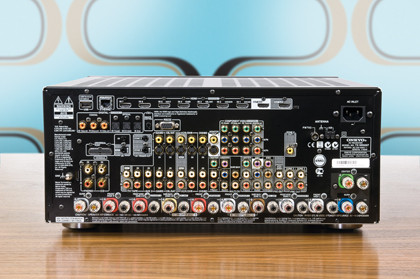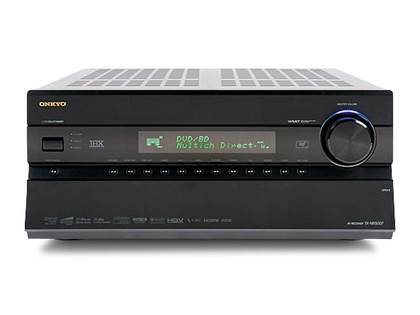TechRadar Verdict
This is the best receiver Onkyo have built and gives the more expensive options something to think about
Pros
- +
Sophisticated and polished sound
- +
Excellent scaling to 1080p
- +
Features galore
Cons
- -
No Wi-Fi
- -
Lacks proprietary anti-jitter
Why you can trust TechRadar
When Onkyo launches a new top-of the-range receiver, you have got to take note. Not only is the brand famed for being the first out with new features, new innovations and new widgets, they are often launched on products at price points well below the competition.
The TX-NR5007 is the company's new flagship receiver; it's got loads of new toys and it's close to half the price of range-topping amps and receivers from the likes of Denon, Pioneer and Yamaha. It's business as usual from Onkyo and we love it.
What isn't usual in the TX-NR5007 is the sound. Gone is Onkyo's house sound that errs on the side of all-action hero with a side-order of bad-ass-bass. No bad thing if all you want to achieve is a home cinema adrenaline ride, of course, and in terms of bang for your buck, Onkyo has been scooping all the Oscars for a while.
But the TX-NR5007 is different. It's a grown-up receiver with neutral balance and spacious presentation, offering a wonderful sense of scale and precision with every movie. From Pixar fairytales to cult classics, this is Onkyo's best all-round performer to date – and that's before you come to its festival of features.
Top of that list is nine channels of amplification. Not only is this easily configurable as a powered multiroom system (eg 5.1 + 2 zones of stereo), it also allows bi-amping or bridging of main channels for better audio performance – and still has enough juice for a powered stereo zone.
However, the real magic of all those power channels is revealed when mated to the Onkyo's excellent Dolby Pro-Logic IIz and Audyssey DSX processing, as this AVR allows full 7.1 plus equal power for height or width channels. In fact, you can even set it up as 5.1 with both height AND width channels – something which I have done and can heartily recommend.
Of course, you lose the rear back channels, and sadly Onkyo has missed a trick on the TX-NR5007 by not offering full 7.1 plus height and width channels (ie 11.1). This could have been achieved with a line level pre-output for a small stereo power amp for those last two channels. One up for Denon's competing AVR 4810, which does just that.
Sign up for breaking news, reviews, opinion, top tech deals, and more.

Thankfully, the NR5007 is not just about the number of channels, it's about the number of bits as well – all 32 of them. Its main processing engine is a trio of TI Aureus 32bit DSP chipsets and there is a whole suite of Burr-Brown 196kHz/32bit DACs to turn the post-processed data streams for each channel into precision analogue sound.
The highest of high-tech continues on the video side, with Silicon Optix's Reon-VX engine and the excellent ISF (Imaging Science Foundation) video calibration for every input source.
In terms of processing, Onkyo has all the Dolby and DTS marques covered including Dolby Volume. It also sports the full Audyssey gamut with MultEQ auto set-up and room EQ, DSX, Dynamic Volume and Audyssey Dynamic EQ. The latter is a system for correcting the room EQ relative to the overall volume and the dynamic range of the material in real time. It gives me a headache just thinking about how complex the processing for that must be.
What won't give you a headache is the wonderful GUI, and intuitive ease of use, day-in and day-out. Onkyo has absolutely nailed the TX-NR5007's interface. It's bold, bright, informative, logical and, best of all, offers excellent text descriptions for every feature, function and setting. It's hands down the best GUI on any flagship receiver to date and pretty much consigns its own Yellow Pages-sized instructional manual to the recycling bin.
Phasers on stun
With the new Star Trek Blu-ray yet again called into action (if you don't own this yet, put the mag down and go and buy it), I put the Onkyo through its paces, and found that from the outset, this is a receiver that is supremely surefooted and blessed with a remarkably even balance.
The bass is deep and potent without being overbearing; the mid-range is wide open and richly detailed and the top-end is smooth and sophisticated. This is the sort of balance that will thrill without offending, no matter what the volume, so it seemed only right to give it a handful.
As Kirk (senior) steers his ship into an inevitable head-on collision in the opening sequence, the Onkyo lights up the room with a huge, immersive festival of sound and effects. Opting for 7.1 plus DLP IIz Height, the soundstage reaches intergalactic proportions and the sheer visceral impact will put a smile on any action movie fan's face. That is a true Onkyo character, but what separates the manly TX-NR5007 from the boys lower down the company's range is the subtlety and uncanny level of detailing.
Dialogue is so very natural with no forced sibilance or boom, and small ambient effects like the sheer scale of the hangers is rendered in the audio equivalent of 3D. Whack up the volume as planet Vulcan crumbles and you're rewarded with a sweeping increase in scale and dynamics. Explosions have real edgy impact and the falling rubble as the temple collapses is so believable my dog abandoned the sofa and hid in the bathroom.

With shouted dialogue over action, when the AVR is at full stretch, there is a little smearing and graininess at the very top of the scale. On lesser amps, it would not be as noticeable, but the 5007's normally liquid-honey top-end makes it stand out. It's not unusual for this to be caused by jitter in the HDMI data stream, so I suspect this very minor gripe will be source dependent.
Unlike its peers, Onkyo does not have a proprietary HDMI sync system to eliminate jitter in the connection between source and receiver. It relies instead on a standard phase-locked loop (PLL), which will reduce jitter but not eliminate it. The upshot, I reckon, is more jitter in the transfer than systems with holistic links such as DenonLink, Sony's HATS or Pioneer's PQLS.
Old dog, new tricks
For those who watch more than Blu-rays, the Onkyo has more tricks up its transistors. Using an off-air Sky feed in standard-def shows superb upscaling to 1080p. With good broadcast SD or DVD material, the 5007 puts a sharp edge and depth to the picture that makes most other AVRs look rather soft and two-dimensional.
Use the ISF calibration tools to tailor each input and you will be rewarded with an image that is vibrant and pans smoothly. And then there is the Onkyo's networking abilities which, in keeping with the fabulous user interface, is absolutely plug 'n' play.
It hooked up to my main PC iTunes library, WMV files on the wife's PC, MP3s on a Ethernet DLNA NAS drive, and even an old sound-server that was wirelessly connected to a remote access point on the same network. I'm pretty sure not one other receiver to date has found all those first off without the use of frequent power cycles, multiple reconnections, and very occasionally, a hammer. Even the vTuner web-radio access makes my Denon AVP-A1HD look slow.
Comparing the TX-NR5007 to its nearest rival, Denon's AVR-4810, you can only say that the performance of both is outstanding. So how does the Onkyo manage to be some £600 lighter on the wallet? The answer is more on the outside than the inside.
The Onkyo does not have Wi-Fi or a second remote for another zone like the Denon; its peripherals such as the set-up mic are rather more plasticky, and the overall build quality is not as beefy as one might like.
For instance, the clear plastic speaker terminals may look like WBTs, but they flex alarmingly given nine pairs of heavy speaker cables hanging out of the back.

All this, despite weighing around 6kg more than the AVR-4810. These omissions are far from essential when it comes to first-class home cinema, of course. None take anything away from the Onkyo's cracking performance and incredible flexibility as the beating heart of a home entertainment system.
The TX-NR5007 is potent, polished and powerful, with an amazing features list at a rather attractive price. And just think how many Blu-rays £600 could buy you...
Follow TechRadar Reviews on Twitter: http://twitter.com/techradarreview
